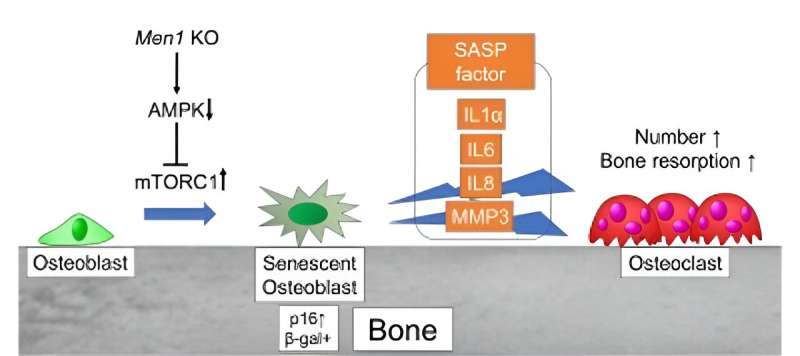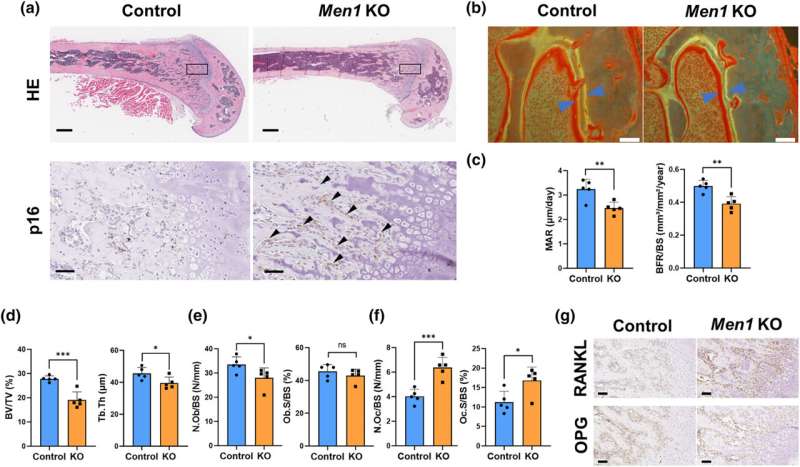This article has been reviewed according to Science X's editorial process and policies. Editors have highlighted the following attributes while ensuring the content's credibility:
fact-checked
peer-reviewed publication
trusted source
proofread
New gene linked to osteoporosis identified

Osteoporosis—weakening of the bones with age—affects millions worldwide, and this figure is increasing annually as the global population ages. It is associated with the aging, or "senescence," of bone cells, but the underlying cell types and mechanisms were unclear.
Now, however, a research team from Osaka University has identified a key osteoporosis-related gene, Men1, and developed a new animal model of this disease.
Bones contain cells called osteoblasts and osteoclasts. Osteoclasts break down old bone tissue in a process called "resorption," allowing it to be replaced with new healthy bone made by osteoblasts. Osteoporosis can result when the breakdown of the old bone occurs at a rate faster than formation of the new bone. Cellular senescence of osteoblasts, reducing their efficiency, might be a reason underlying this imbalance.
A gene called Men1 is linked to a genetic condition known as MEN1, causing benign tumors and associated with both cellular senescence and the development of osteoporosis early in life. The team investigated the role of Men1 in age-related osteoporosis and found that elderly mice showed both reduced levels of Men1 and increased activity of senescence-related genes in osteoblasts.
They then generated a mouse model where Men1 could be inactivated specifically in osteoblasts. The bones of these mice resembled the fragile bones seen in elderly humans.
"The osteoblasts showed reduced bone formation activity, and accelerated cellular senescence through a pathway called mTORC1," explains lead author Yuichiro Ukon, "while the numbers of osteoclasts were increased, increasing bone resorption." Inactivation of Men1 thus upset the balance between bone breakdown and formation, leading to the development of osteoporosis.

This new mouse model is particularly important because most studies of osteoporosis use elderly mice to mimic the human symptoms. However, natural aging involves multiple factors that influence the onset of osteoporosis, including reduced activity with increasing age and menopause-related hormonal changes.
"This model is the first time that the cellular senescence underlying osteoporosis has been modeled without the confounding factors present in elderly mice," explains corresponding author Takashi Kaito, "and is therefore a key step forward in our understanding of the biological mechanisms behind this disease."
The team also showed that the use of a drug called metformin, known to suppress the mTORC1 cellular senescence pathway, was able to suppress this senescence in osteoblast cells in vitro, and to partially restore the bone structure in Men1-deficient mice, indicating the potential effectiveness of osteoporosis treatments targeting cellular senescence.
This study is therefore highly significant in advancing our understanding of osteoporosis and potential treatments, as well as identifying biomarkers of the disease for evaluating the efficiency of prospective therapies.
The mice developed here also provide a novel model of osteoporosis, which is key for ongoing research. Because cellular senescence has been linked to other age-related diseases and cancers, this work may provide insights into many other diseases.
The article, "Cellular senescence by loss of Men1 in osteoblasts is critical for age-related osteoporosis," was published in Aging Cell.
More information: Yuichiro Ukon et al, Cellular senescence by loss of Men1 in osteoblasts is critical for age‐related osteoporosis, Aging Cell (2024). DOI: 10.1111/acel.14254



















